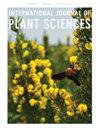长期迁地栽培过程中野酒的遗传和花性状的变化
IF 1.5
3区 生物学
Q3 PLANT SCIENCES
引用次数: 0
摘要
研究的前提。本研究利用自20世纪30年代以来一直被移地栽培的一种罕见的地方特有物种Oenothera organensis (onagracae),研究了长期移地栽培对遗传变异和花性状的潜在影响。在气候变化和生境破坏对全球生物多样性构成威胁的背景下,植物园迁地保护是保护濒危植物的重要途径。迁地栽培活植物的遗传后果包括遗传多样性的减少和由于种群瓶颈造成的近交萧条。此外,迁地种群可能由于选择压力的转移或放松而经历性状变化。这些变化可能导致适应性下降或失败,当迁地种群重新引入野外。本研究从中性遗传多样性和花性状方面探讨了迁地栽培的潜在缺陷。方法。为了验证移地栽培对中性遗传多样性的潜在影响,我们利用8个微卫星标记分析了多个移地栽培和野生稻居群的遗传组成。此外,我们还利用普通园林实验,对迁地栽培和野生衍生群体的花性状和物候进行了研究,以验证迁地栽培是否会改变或增加花性状的变异。关键的结果。移地居群的中性遗传多样性普遍降低,不能捕获野生居群中观察到的所有等位基因。迁地种群的高成对亲缘关系也表明了潜在的近交。与野生植物相比,人工栽培的迁地植物在花性状和表型分布上表现出更高的变异性,这可能是由于选择压力的放松或转移。结论。如果不仔细考虑和维护植物群体的遗传变异和性状,长期的移地栽培会减少中性遗传多样性,改变保守谱系的表型。大多数迁地保护的指导方针侧重于增加种群规模和汇集来自多个来源的遗传多样性以保持多样性。我们的研究表明,在迁地环境中放松或转移的选择可能导致表型的转移,因此管理实践也应该在尽可能接近自然环境的条件下维持迁地植物。本文章由计算机程序翻译,如有差异,请以英文原文为准。
Genetic and Floral Trait Changes in Oenothera organensis (Onagraceae) during Long-Term Ex Situ Cultivation
Premise of research. This study examines the potential effects of long-term ex situ cultivation on genetic variation and floral traits using a rare endemic species, Oenothera organensis (Onagraceae), which has been cultivated ex situ since the 1930s. Ex situ conservation in botanic gardens is an important approach to safeguard endangered plant species, especially given current threats to global biodiversity from climate change and habitat destruction. The genetic consequences of ex situ living plant cultivation include reduction in genetic diversity and inbreeding depression owing to population bottlenecks. In addition, ex situ populations might experience trait changes because of shifted or relaxed selection pressure. These changes can cause fitness declines or failure when ex situ populations are reintroduced into the wild. This study examines potential drawbacks of ex situ cultivation by focusing on neutral genetic diversity and floral traits. Methodology. To test the potential effects of ex situ cultivation on neutral genetic diversity, we used eight microsatellite markers to examine the genetic composition of multiple ex situ and wild populations of O. organensis. In addition, we applied a common-garden experiment to examine floral traits and phenology of ex situ and wild-derived populations to test whether ex situ cultivation can shift or increase the variance of floral traits. Pivotal results. The ex situ populations of O. organensis generally had reduced neutral genetic diversity and failed to capture all of the alleles observed in the wild populations. High pairwise relatedness in the ex situ population also indicated potential inbreeding. Cultivated ex situ plants exhibited higher variability in floral traits and shifted phenotypic distribution compared with wild-derived plants, which may be due to relaxed or shifted selection pressure. Conclusions. Without careful consideration and maintenance to preserve genetic variation and traits in plant populations, long-term ex situ cultivation can reduce neutral genetic diversity and change the phenotypes of conserved lineages. Most guidelines for ex situ conservation focus on increasing population sizes and pooling genetic diversity from multiple sources to maintain diversity. Our study demonstrates that relaxed or shifted selection in an ex situ setting may lead to shifted phenotypes, so management practices should also maintain ex situ plants under conditions that are as close as possible to the natural settings.
求助全文
通过发布文献求助,成功后即可免费获取论文全文。
去求助
来源期刊
CiteScore
4.50
自引率
4.30%
发文量
65
审稿时长
6-12 weeks
期刊介绍:
The International Journal of Plant Sciences has a distinguished history of publishing research in the plant sciences since 1875. IJPS presents high quality, original, peer-reviewed research from laboratories around the world in all areas of the plant sciences. Topics covered range from genetics and genomics, developmental and cell biology, biochemistry and physiology, to morphology and anatomy, systematics, evolution, paleobotany, plant-microbe interactions, and ecology. IJPS does NOT publish papers on agriculture or crop improvement. In addition to full-length research papers, IJPS publishes review articles, including the open access Coulter Reviews, rapid communications, and perspectives. IJPS welcomes contributions that present evaluations and new perspectives on areas of current interest in plant biology. IJPS publishes nine issues per year and regularly features special issues on topics of particular interest, including new and exciting research originally presented at major botanical conferences.

 求助内容:
求助内容: 应助结果提醒方式:
应助结果提醒方式:


